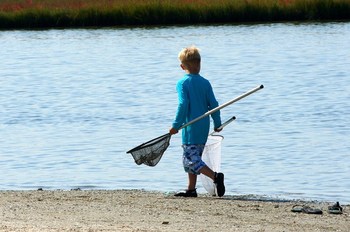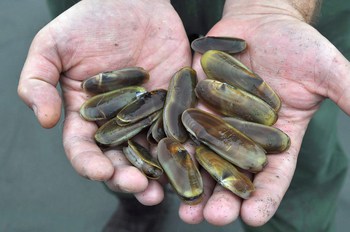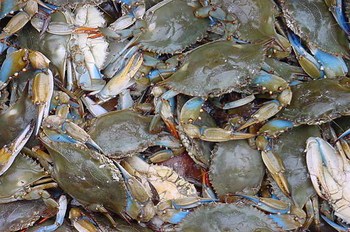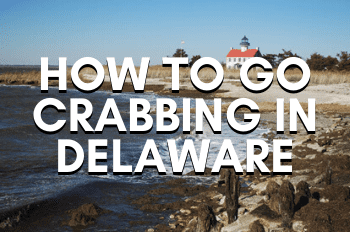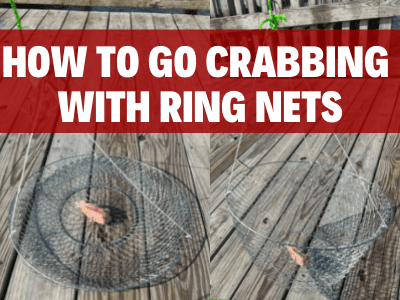How to Catch a Crab by Hand | Dip Net Crabbing 101
There’s nothing more fulfilling than ditching the traps and catching a crab dinner by hand. It’s a more difficult time consuming, but they always taste better knowing you pulled that crab out of the water and onto your dinner plate.
The closest thing to going crabbing with your bare hands is using a dip net. The concept is simple: take a dip net and wade into a cove or shoreline, then simply scoop up crabs as they scurry by. This skill takes a lot of patience, hand-eye coordination, and practice. Let’s take a good look into how to go crabbing with a dip net.
Dip Net Crabbing 101
This is a skill that’s being killed by the overuse of ring nets and crab pots. Sure, it’s a much easier way to go crabbing, but you miss out on the experience of wading out in the water on a warm summer day. Like I said before, the crabs taste a lot better knowing that you caught them.
Where to go Crabbing
First, you’ll need to find a spot. You’re going to need shallow, relatively calm waters. A very good spot would have clear water all the way to the bottom where crabs like to hang out. If you don’t have a spot in mind, it’s time to go exploring. Places like that are very rare in colder states north of Maryland, but not impossible to find. A good place to start looking is tidal creeks, saltwater marshes, and shallow areas along rivers.
To all you Florida readers, try the Everglades! Anywhere that’s shallow and has blue crabs will do just fine. Just keep an eye out for alligators!
For you crabbers on the west coast, you can go dip net crabbing in bays and rivers that feed into the Pacific. The water may be a bit rougher, but Dungeness crabs are tougher than blue crabs found on the east coast. They like to hop onto fishermen’s lines out in the crashing waves and eat their bait, so I’m sure you can scoop a few up with your dip net.
Just remember to pick a calm day to go dip net crabbing. It’s inefficient and quite frankly embarrassing to trip over yourself trying to catch crabs in crashing waves. You’ll have better visibility and overall better time on a calm day.
Supplies
Secondly, you’ll need some supplies. The first thing to look for is the right dip net (obviously). The bigger the opening to the net, the better. You can find one at any Bait & Tackle shop along with most stores selling fishing supplies. Look for a net that has a handle at least 3 feet in length, and a net with a 1×1 ft opening for crabs. Something small enough that it’s easy to control, but large enough to have a better chance of catching crabs.
I use a MelkTemn Fishing Net on my crabbing trips. It’s a folding, lightweight, and affordable dip net that can come in handy out on the water. Click here to check its current price on Amazon.
You’ll also need some supplies to help transport the crabs. I recommend bringing a bucket and/or a cooler, as well as ice packs and thin towels.
A bucket or a cooler will do just fine transporting crabs. I recommend a cooler if you plan on a longer crabbing trip on a hotter day to keep the crabs you catch alive and well. Make sure there’s enough room in the container to evenly spread out the crabs so they aren’t stacked on each other as much, while still being light enough to easily carry around with you.
Ice packs come in handy to keep the crabs cool. When crabs are exposed to cooler temperatures, they slow down and almost fall asleep. Most recreational crabbers use this trick to keep crabs alive until they’re thrown on the steamer. When they’re asleep they are much easier to handle, and it’s a great way to avoid getting pinched.
Thin towels come in handy to keep the crabs cool. Sometimes if you throw the crabs directly on a very cold surface, the shock can kill them. I recommend lining a towel on the ice to prevent any shock. Feel the towel after laying it over the ice packs, if the towel stops the cold air from seeping through, you might be fine without them.
Lastly, you will need a license and a crab gauge. It’s important to follow your state’s rules and regulations for catching crabs. Unless you are in a spot labeled otherwise, you will most likely need a recreational fishing license to catch crabs. To apply for a license, simply go to Google’s search engine and type: “(your state) DNR”. You will be taken to your state’s Department of Natural Resources website where you can apply for a license and see any rules and regulations regarding catching crabs.
Most, if not all, coastal states have a size limit on crabs. For example, in South Carolina, you aren’t allowed to keep blue crabs that measure less than 5 inches across the carapace (from point to point on top of its shell). Some expert crabbers can tell just by eyeballing it, but I highly recommend you bring a crab gauge to be sure. If you don’t have one, a ruler or tape measure will do just fine.
Technique
Now that you have a good spot and everything you need, let’s go dip net crabbing. Dip net crabbing is an art. It takes serious patience, an eagle eye, and someone who isn’t easily discouraged. You’ll miss the first few times, but eventually, you’ll get the hang of it.
The first thing you need to do is spot the crab. This is why calm, clearer waters are key. If you slowly wade through the water you’ll be sure to spot one. Try not to splash or make any loud noises. I encourage that you bring along a friend who would appreciate the sport and has a good sense of vision.
Once you spot the crab, now you have to get close enough not to scare it away. Wade a bit slower and try not to stir up any sand. The crab may start to move away but keep at it. Once you’re around 3-5 feet away from the crab, it’s your time to pounce. Aim your net behind the crab and scoop it up from behind. You’ll have to be quick, they’re surprisingly fast.
A clever trick I’ve found is that you can get a friend to help lure the crab towards you. Once you spot a crab, have him or she go around so that the crab is between you two. Your friend should then slowly walk towards you, causing the crab to back towards you. Once it’s close enough, simply scoop it up with your net.
If you do everything right, you should have a blue crab scurrying around in your net. The Melktemn Fishing Net (click here to check its price on Amazon) Has a 10” deep square net, so your crab isn’t going anywhere. I recommend staying near shore so that you can easily measure your crabs then leave them in your bucket or cooler. Alternatively, you can bring a paddleboard or kayak along for the trip and have it nearby. It’ll make your trip a lot easier and you won’t have to travel back and forth every time you catch a crab.
A cool trick is to keep your crab gauge/ruler on a keychain. Simply loop a keychain through the measuring device then attach it to a mini carabiner that you clip to your belt loop. It makes measuring the crab much easier.
This may sound a bit time consuming and advanced. Let’s look at a few easier methods to go crabbing.
Hand Lines
Also known as chicken necking, you’ll have a much easier time catching crabs by hand with this method. It’s mainly the same concept, except you’ll be using some bait to pull the crabs towards you to scoop them up. I highly recommend this method if you are having trouble finding the perfect spot go crabbing with a dip net. You don’t have to get wet with this method as you can easily setup from shore. This is still a hands-on and labor-intensive way of catching crabs, so you can still fairly say you’re catching crabs by hand.
It’s pretty simple. Tie a piece of chicken or fish to the end of a 6-12 ft string (depends on the depth of the water) and throw it in the water. It’s best if the water is at least 2 feet deep. Now you play the waiting game. Keep an eye on your line. If it starts to become taught, there’s a crab trying to make a run for it with your bait.
Now you have to very slowly pull the crab towards you, the slower the better. Have a friend nearby with a dip net on hand. Once the crab is near the surface, scoop it up like you would dip net crabbing. Aim the net behind the crab and scoop up from behind.
This method also takes a bit of patience, here’s an even easier method.
Ring Nets
This is a step up from dip nets and handlines. If you find yourself with nothing but a pier to go crabbing from, this is the trap for you. It relates to the handline crabbing method; wait for the crabs to come to you.
You simply tie some bait to the center of your net -the chicken will do just fine- and throw it into the water. After 10 minutes or so, pull the net up and see what you got. If you’re lucky, you will have caught a crab. Running 4 or 5 rings will up your chances of catching a crab.
Related Questions
If you have any questions, feel free to leave a comment and I’ll get back to you! Here are a few of the most commonly asked questions.
What should I use for bait?
The great thing about catching crabs is that they aren’t very picky. They’ll eat anything from cat food to another dead crab. With dip net crabbing, you aren’t using any bait. However, with ring nets and hand lines, you are. I recommend using chicken necks, a very popular bait for blue crabs. They’re easy to tie and last a long time in the water. If you’re fishing for Dungeness, you’ll have to double or triple your bait; Dungeness crabs like to eat.
I wrote an article on the best crab bait, feel free to check it out.
Can I go crabbing all year round?
Depending on where you live you can go crabbing year round. Crabs like to burrow in the mud when temperatures get colder and food gets scarce. I recommend crabbing in the fall and summer months when crabs are most active.
Can I go crabbing at night?
Yes, you can go crabbing at night. You’ll need a flashlight and a coat to stay warm, but it’s quite do-able. However, some states have regulations against crabbing at night. For example, South Carolina allows crabbing from October to May 30 minutes before sunrise through 30 minutes after sunset. Check with your state’s DNR website to see if they allow crabbing at night.
What tide is best for crabbing?
The best time for crabbing is Slack Tide. This is right between low and high tide when the water is moving the fastest. The crabs like to let the tides carry them around as they search for food, so you’re much more likely to catch a crab at this time.


